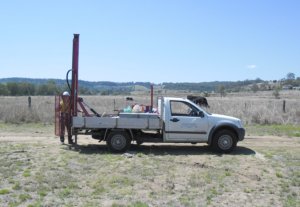As part of the design and approval process of building your new house you will require a ‘Site Investigation Report’ sometimes referred to as a ‘Geotechnical Report’.
For a typical suburban subdivision for a one or two storey house on a standard block around 800m2. these cost in the order of $1,500 – $2,000,
What They Do
The site investigation company will normally send out a truck mounted drilling rig to site.
The rig operator will have a look at the site for any potential problems and drill three holes to a depth of about 2 – 3m, or until they hit rock.
At least one of these holes will include any problem areas identified from the visual inspection such as wet areas and disturbed ground.
For larger blocks, larger houses, and houses with more complex structures (e.g.underground garages) more boreholes, deeper bore holes, and more testing will be required which will all add to the cost.
Samples of the different materials encountered will be classified to be able to assist in assessing the strength of the material
The Results
A report will then be prepared based on the tests, and any previous information about soils in the locality.
The Report will give recommendations about foundations for structures on the site.
The key part of the recommendation is usually a foundation classification as this can adds tens of thousands of dollars to the cost of the build
Limitations on Report
A couple of things to remember about these reports are:
- The recommendations assumes that the boreholes accurately reflect the condition for the whole site.
- The ground can be exceptionally variable and the borehole are testing much less than a hundreth of one percent of the soil that the house will be standing on. (During excavation the builder may encounter worse conditions that need a stronger foundation with additional costs)
- If the site has a slope which requires cut and fill the foundation may need to be to a higher classification than the report recommendations . . . at an additional cost.
For more posts related to land see Blocks
